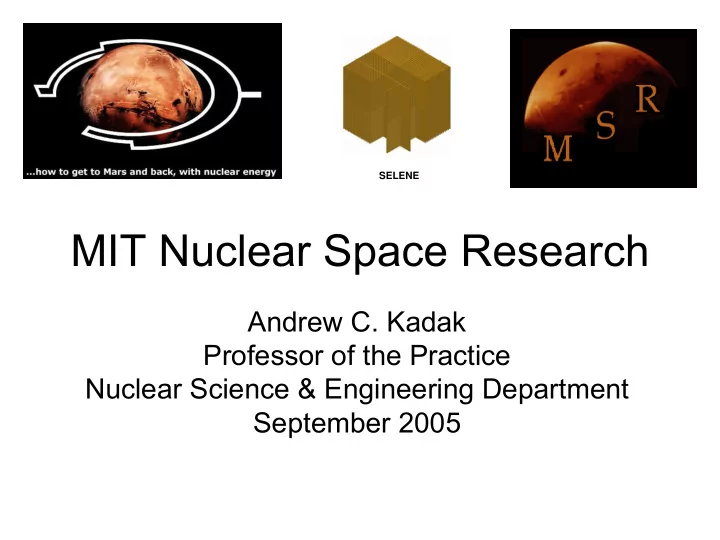

SELENE MIT Nuclear Space Research Andrew C. Kadak Professor of the Practice Nuclear Science & Engineering Department September 2005
MIT’s Space Initiative • New to the Department – started in 2003 • Project undertaken as part of design course – Manned Mission to Mars – How to get people to Mars and back with Nuclear Energy – Selene - Sodium-Cooled Epithermal Long-term Exploration Nuclear Engine (MS thesis) – The Martian Surface Reactor: An Advanced Nuclear Power Station for Manned Extraterrestrial Exploration – Extraterrestrial Nuclear Power Stations: Transportation and Operation (MS Thesis) – Participated in MIT/Draper Lab NASA Concept Exploration and Refinement Study for future space missions (CERS) 2
Manned Mission to Mars • Mission plan • Decision methodology • Space power system • Surface power system • Conclusions 3
4
5 Landing Site Layout for 1 st Manned Mission
Manned Missions : 6 Launch Opportunity 3
ANDIE Advanced Nuclear Design for Interplanetary Engine 1. Molten salt transfers the heat from the core to the radiator 2. All power is radiated towards TPV collector 3. TEM self powered pumps circulate the molten salt coolant 4. TPV collectors generate DC from thermal radiation 5. Residual heat is dissipated into outer space 7
Surface Power System • Cooled by Martian atmosphere (CO 2 ) – Insensitive to leaks • Shielded by Martian soil and rocks – Low mass • Hexagonal block type core – Slow thermal transient (large thermal inertia) • Epithermal spectrum – Slow reactivity transient – Low reactivity swing 8
CADEC CO 2 cooled Advanced Design for Epithermal Converter 5 • Pressurized CO 2 from atmosphere cools the COMPRESSOR TURBINE GENERATOR core 1 • Direct, closed, 2 recuperated Brayton cycle for electricity 4 production ( η net ~20%) REACTOR 6 3 RECUPERATOR PRECOOLER 9
Martian Surface Reactor Group December 3, 2004
MSR Assembly Sketches 11
MSR Assembly Sketches (2) 12
PCU – Heat Exchanger to Radiator • Heat Pipe Heat Exchanger 13
Shielding - Design • Two pieces, each covering 40º of reactor radial surface • Two layers: 40 cm B 4 C (yellow) on inside, 12 cm W (gray) outside • Scalable – at 200 kW(e) mass is 2.19 metric tons – at 50 kW(e), mass is 14 1.78 metric tons
Shielding - Design (3) • Using a shadow shield requires implementation of exclusion zones: • Unshielded Side: core – 32 rem/hr - 14 m – 2.0 mrem/hr - 1008 m – 0.6 mrem/hr - 1841 m • Shielded Side: – 32 rem/hr - inside shield – 400 mrem/hr – at shield boundary – 2.0 mrem/hr - 11 m 15 – 0.6 mrem/hr - 20 m
MSR Assembly Sketch 16
Design of Sodium-cooled Epithermal Long- term Exploration Nuclear Engine • Response to NASA comment that PU fueled reactors are politically incorrect. Selene 97% Enriched U235 17
Extraterrestrial Nuclear Power Stations: Transportation and Operation • Reviewed Launch Requirements • Cassini Safety Analysis • Approval Process • Landing options for the moon • Startup of MSR • Operational Needs - Shielding • Electric Connections 18
NASA Exploration and Refinement Study • MIT and Draper Labs - contract with NASA to review future space architecture options for deep space travel - “Mars Back” • Development of specifications for Crew Exploration Vehicle (CEV) • Also types of systems needed for manned exploration and mission options. • Nuclear Engineering Students part of several teams - surface operations and power for propulsion. 19
Future Directions • Focus on power systems • Nuclear Thermal Rocket • Development of power conversion systems including thermionic systems • Optimization of shielding and radiator designs • Consideration of real problems for operating reactors in space - maintenance, radiation exposure, power supplies. 20
Recommend
More recommend